
Beginner’s Guide to Metal Plate Bending Machines- Getting Started
- By:Metmac
- 2024-08-06
- 125
Introduction:
Are you a metalworking enthusiast or a budding fabrication wizard? Look no further than the realm of metal plate bending machines”the unsung heroes of the metalworking world. Unleash your inner bender and embark on a thrilling journey into the intricate world of metal shaping.
Understanding Metal Plate Bending Machines:
Metal plate bending machines, also known as press brakes, are essential tools for bending and shaping metal plates with precision and efficiency. They consist of a rigid frame, a hydraulic ram, and a set of punches and dies. The ram exerts immense force on the metal plate, causing it to deform along the shape of the die.
Types of Metal Plate Bending Machines:
There are various types of metal plate bending machines, each designed for specific applications:
Mechanical Press Brakes: Powered by a mechanical flywheel, these machines provide high tonnage capacity for heavy-duty bending.
Hydraulic Press Brakes: Utilizing hydraulic cylinders, these machines offer smooth and precise bending with variable force adjustment.
Electric Hybrid Press Brakes: Combining the strengths of mechanical and hydraulic systems, these machines provide both precision and power.
Essential Components of a Metal Plate Bending Machine:
Frame: The rigid structure that supports the machine’s components.
Ram: The movable part that exerts force on the metal plate.
Punch: The tool that presses down on the metal plate.
Die: The tool that forms the shape of the bend.
Backgauge: A movable gauge that positions the metal plate precisely under the punch.
Getting Started:
1. Safety First: Wear appropriate safety gear and ensure proper machine setup.
2. Choose the Right Punch and Die: Select the punch and die that match the desired bend radius and metal thickness.
3. Set the Backgauge: Position the metal plate correctly using the backgauge.
4. Apply Force: Engage the machine and apply the necessary force to bend the metal plate.
5. Monitor the Bend: Observe the bending process and adjust the force or backgauge as needed to achieve the desired shape.
Tips for Successful Metal Plate Bending:
Use sharp punches and dies for clean bends.
Lubricate the metal plate for reduced friction.
Bend the metal slowly to prevent cracking.
Adjust the backgauge accurately for precise bends.
Seek professional advice for complex bending operations.
Conclusion:
Mastering the art of metal plate bending requires patience, precision, and an unwavering love for metalworking. By understanding the basics, selecting the right machine, and following these tips, you can unlock the full potential of these magnificent machines and transform flat metal plates into intricate works of art or engineering marvels.
-
Advanced Sheet Metal Rolling, Cutting, and Folding Machines for Efficient Fabrication
2025/10/22 -
High-Precision Sheet Metal Bending and Cutting Solutions for Modern Manufacturing
2025/10/22 -
High-Precision Solutions from Leading Sheet Metal Cutting Machine Manufacturers
2025/09/11 -
Reliable Sheet Metal Equipment for Sale to Support Precision Fabrication
2025/07/17
-
Advanced Sheet Metal Rolling, Laser Cutting, and Folding Machines for Precision Fabrication
2025/10/31 -
High-Performance Sheet Metal Bending and Cutting Machines for Modern Fabrication
2025/10/31 -
High-Quality Sheet Metal Equipment for Sale: Efficient Solutions for Modern Manufacturing
2025/10/31 -
High-Performance Sheet Metal Equipment for Sale: Forming and Shearing Solutions for Modern Fabrication
2025/10/22
-
A Guide to the Latest Innovations in Sheet Metal Folding Machines
2024/11/29 -
Key Features to Consider When Investing in a Sheet Metal Folding Machine
2024/11/28 -
Enhancing Precision with Advanced Sheet Metal Folding Machines
2024/11/27 -
How to Choose the Right Sheet Metal Folding Machine for Your Workshop
2024/11/26






